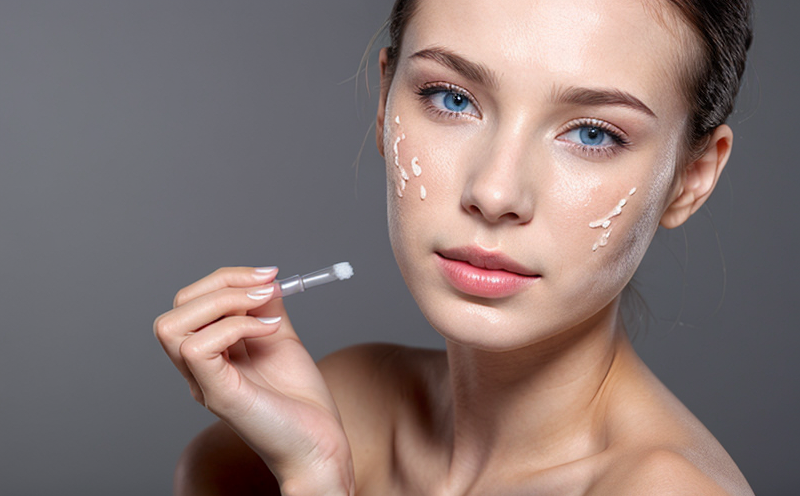Sensitization Testing in Hair Care Products
Sensitization testing is a critical component of ensuring that cosmetic products are safe and effective. In particular, hair care products must undergo rigorous testing to identify potential allergens or irritants that could cause adverse reactions when used by consumers.
The process typically involves three main steps: specimen preparation, in vitro testing, and interpretation of results. Specimen preparation includes the selection of appropriate test materials based on the type of product being evaluated (e.g., shampoos, conditioners). In vitro methods are preferred as they offer a controlled environment where variables can be precisely managed.
One common approach is to use human lymphocytes from volunteers who have not previously shown signs of sensitivity towards the ingredients in question. These cells are then exposed to extracts or preparations derived directly from the hair care product under investigation. The response of these cells is monitored over time using various techniques, including enzyme-linked immunosorbent assays (ELISAs) and cytokine quantification.
The results provide valuable insights into whether specific components within the formulation might trigger an immune response in susceptible individuals. This information helps manufacturers make informed decisions about ingredient selection and formulation adjustments to minimize risks associated with sensitization.
It's important to note that sensitization testing goes beyond merely identifying allergens; it also plays a crucial role in understanding how different substances interact within complex formulations. By comprehensively evaluating each component, companies can better predict which combinations may pose higher risk factors for consumers.
This level of scrutiny ensures compliance with international standards such as ISO 10993-18:2017 and EU Directive (EC) No 726/2004 on cosmetic products. Such adherence not only protects end-users but also enhances brand reputation through transparency and accountability.
Moreover, ongoing advancements in analytical methodologies continue to improve the accuracy and efficiency of sensitization testing procedures. As technology evolves, so does our ability to refine these tests further, leading to more precise assessments that reflect real-world scenarios as closely as possible.
Quality and Reliability Assurance
The quality assurance process for hair care products begins with thorough documentation of all test procedures followed during the sensitization testing phase. This includes detailed records of specimen preparation, reagent usage, incubation conditions, and any other relevant factors that could influence outcomes.
Compliance officers play a vital role in ensuring that these protocols are consistently applied across multiple batches or versions of a product. By maintaining strict adherence to standardized methods outlined by recognized bodies like ISO 10993-18:2017, laboratories can guarantee consistent and reliable results.
R&D engineers also contribute significantly to this process by continuously refining formulation designs based on feedback from sensitization tests. They work closely with quality assurance teams to incorporate findings into future iterations of products, thereby enhancing overall safety profiles while preserving efficacy.
For procurement professionals involved in sourcing raw materials for hair care products, understanding the importance of rigorous testing ensures that only high-quality ingredients are used. This approach not only supports better decision-making but also fosters trust among stakeholders throughout the supply chain.
In summary, quality and reliability assurance extend far beyond just conducting tests; it encompasses a holistic approach encompassing documentation, collaboration, and continuous improvement aimed at delivering superior outcomes consistently.
Customer Impact and Satisfaction
The results of sensitization testing significantly impact customer satisfaction by addressing one of the most pressing concerns for consumers: product safety. When manufacturers take proactive steps to identify potential allergens or irritants early in development, they demonstrate a commitment to protecting their customers' well-being.
This transparency fosters trust between brands and their audience, which is essential in today's competitive market where information about ingredient lists can be easily accessed through various platforms. Consumers appreciate knowing that companies are invested in minimizing risks associated with sensitization while still delivering effective treatments for common hair issues like dryness or damage.
Furthermore, successful completion of these tests provides peace of mind for users who may have pre-existing sensitivities to certain compounds commonly found in cosmetics. Knowing that their chosen product has been rigorously evaluated helps reduce anxiety and enhances overall satisfaction with the brand experience.
From a broader perspective, implementing robust quality assurance practices contributes positively towards building long-term relationships with customers. By consistently delivering safe, reliable products backed by sound scientific evidence, companies can establish themselves as leaders in the industry.
Environmental and Sustainability Contributions
The pursuit of environmental sustainability aligns closely with the objectives set forth by various international organizations focused on reducing waste and promoting responsible resource management. Sensitization testing plays a part in this effort by encouraging manufacturers to adopt eco-friendly practices throughout the product lifecycle.
For instance, choosing biodegradable packaging materials or sourcing sustainable ingredients can help minimize environmental impact while still achieving desired performance metrics for hair care products. Manufacturers who prioritize these aspects contribute positively towards global efforts aimed at combating climate change and preserving natural resources.
In addition to direct contributions made through product design choices, sensitization testing also supports broader sustainability goals by preventing unnecessary production runs or recalls due to safety issues. By identifying problematic ingredients early in the process, companies can avoid wasting valuable resources on potentially unsafe formulations that would ultimately end up as waste if not detected earlier.
Furthermore, transparent communication regarding test results allows consumers to make informed choices about purchasing sustainable products based on their own values and preferences. This mutual understanding fosters greater trust between brands and customers, encouraging continued support for environmentally responsible initiatives.





